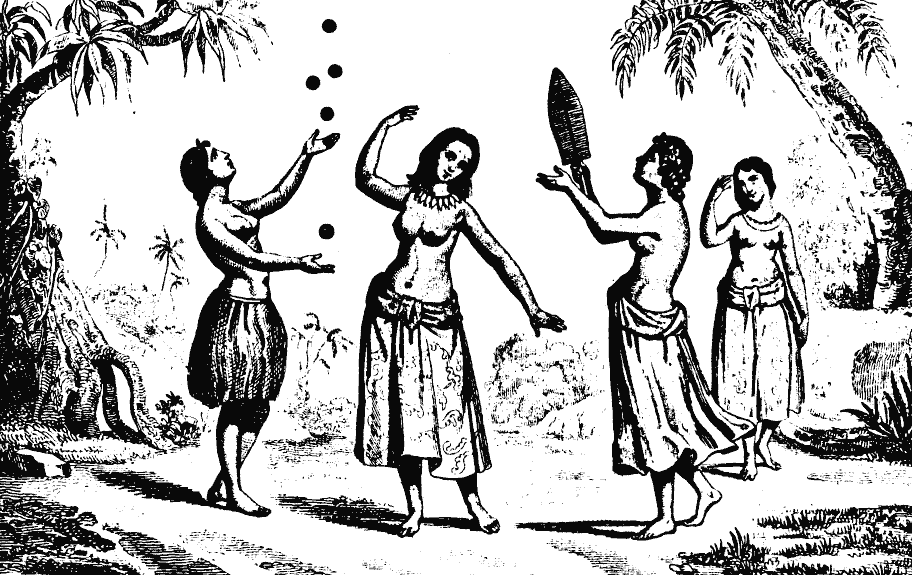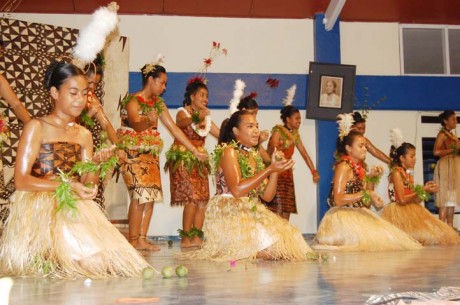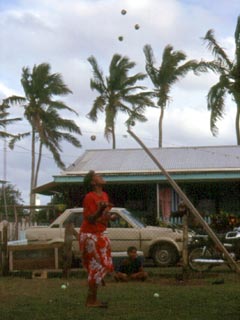Guest Post: Ruth Elayne Kongaika
When I was a young girl, we played hopscotch, jump rope and jacks. In Tonga, primary school girls learn to juggle (hiko). Many of them continue juggling for fun and later on for competitions. These jugglers develop great hand-eye coordination and keen concentration skills. The art of juggling is not taught to the young boys of Tonga, although there are some who do it secretly, but it is mostly considered a woman’s talent in Tonga.
 If you asked the average Tongan, they may not be able to tell you the origin of juggling in the islands. However, a common myth is told about a blind woman named Hikuleo, who was the head goddess of the underworld. She would stay in her own house, because if she were to leave her home, there would be an earthquake. She would steal the eyeballs of anyone who attempted to approach her in the underworld unannounced or without permission and keep them in a wooden bowl. She would call to her girls in the underworld to come and juggle with the eyeballs. Because of this story, superstitious Tongan girls will never juggle at night, since they are afraid that their eyeballs may be stolen.
If you asked the average Tongan, they may not be able to tell you the origin of juggling in the islands. However, a common myth is told about a blind woman named Hikuleo, who was the head goddess of the underworld. She would stay in her own house, because if she were to leave her home, there would be an earthquake. She would steal the eyeballs of anyone who attempted to approach her in the underworld unannounced or without permission and keep them in a wooden bowl. She would call to her girls in the underworld to come and juggle with the eyeballs. Because of this story, superstitious Tongan girls will never juggle at night, since they are afraid that their eyeballs may be stolen.
 In Tonga, juggling is not usually done with balls, but with small fruit like tangerines, limes or tui tui nuts. When we lived in Tonga, what amazed me was the number of objects they could juggle all at once. I have seen as many as ten fruit being juggled at a time. Five was a common number to start with. Often they would have a bowl of extra fruit nearby so they could grab and add one more to the circle.
In Tonga, juggling is not usually done with balls, but with small fruit like tangerines, limes or tui tui nuts. When we lived in Tonga, what amazed me was the number of objects they could juggle all at once. I have seen as many as ten fruit being juggled at a time. Five was a common number to start with. Often they would have a bowl of extra fruit nearby so they could grab and add one more to the circle.
 I think because the girls start so young, it seems very easy to them. Most Tongan children do not have a barrage of toys, like some children in wealthier countries do, so they have to create their own fun. This is an inexpensive talent to develop. Besides the coordination and concentration skills learned from juggling, I believe it is a good preparation for motherhood, when women learn to juggle babies, housekeeping, cooking, being a spouse and other familial responsibilities.
I think because the girls start so young, it seems very easy to them. Most Tongan children do not have a barrage of toys, like some children in wealthier countries do, so they have to create their own fun. This is an inexpensive talent to develop. Besides the coordination and concentration skills learned from juggling, I believe it is a good preparation for motherhood, when women learn to juggle babies, housekeeping, cooking, being a spouse and other familial responsibilities.
To help in keeping the rhythm going during their juggling, the Tongans sing a little song. It puts them into a trance which helps their concentration. Once someone in a village starts juggling, the others want to join in. Before you know it, there are several young girls standing, kneeling or sitting, all the while laughing as some drop their fruit. The last person to drop all of their fruit is viewed with admiration. Juggling is considered a game for amusement sake. They do not do it for entertainment, like in a circus, but more of a fun little diversion to their chores and schoolwork.
Clowns in a circus usually juggle with a simple figure-of-eight pattern, which involves throwing the ball up through the middle and over the sides. The girl and women jugglers do it in a circle and it can get very high, depending on how many items are being used. It really is amazing to watch, and hopefully it will not become a lost art.
In 1978, The Los Angeles Times wrote that Nuku’alofa, the capital of Tonga had more jugglers per square mile than any country in the world. It could still be, but it is now more commonly found in the villages than in the capital. If you are fortunate enough to capture women juggling in Tonga, consider yourself blessed.
Ruth Elayne Kongaika was raised in the mainland, USA, but has been living in the South Pacific for the past forty years. She enjoys trying to capture the beauty of the Polynesian islands through her photography, painting and writing. She has a blog which shares some of her art and favorite subjects at:
email: kongaikr@byuh.edu












